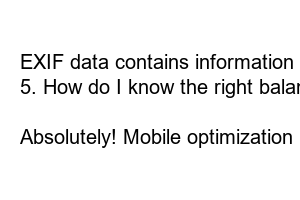사진 용량 줄이는 법
Title: How to Reduce Photo Size: Quick and Easy Tips
Introduction:
In this digital era, where images play a crucial role in capturing attention, it’s essential to ensure your photos are optimized for online use. By reducing photo size, you can enhance webpage loading speed, save storage space, and improve user experience. In this blog post, we’ll guide you through some simple techniques to effectively reduce photo size without compromising quality.
I. Why Reduce Photo Size?
By reducing photo size, you can optimize your website or blog for faster loading speed, allowing visitors to access your content quickly and easily.
II. Compressing Photos:
With various online tools and software available, compressing photos has become a breeze. *These tools offer automatic image optimization, reducing file size without affecting image quality.*
III. Resizing Photos:
Resizing your photos involves adjusting their dimensions or resolution to match your requirements. *With the right tools, resizing a photo is a matter of a few clicks, ensuring optimum quality at smaller file sizes.*
IV. Cropping and Clipping:
Cropping and clipping refer to trimming unwanted parts of an image. *By removing unnecessary elements, you can significantly reduce file size while maintaining visual appeal.*
V. JPEG vs. PNG:
Choosing the right image format is crucial when reducing photo size. *While JPEG is ideal for photographs, PNG is more suitable for graphics or images with transparency.*
VI. Removing EXIF Data:
EXIF data contains information about the camera settings and location of a photo, increasing file size. *By removing this data, you can further shrink your photo size.*
VII. Quality vs. Size:
It’s important to strike a balance between image quality and size reduction. *Adjusting the compression ratio or choosing appropriate optimization settings can help you maintain a satisfactory image quality while reducing file size.*
Summary:
Reducing photo size is a key aspect of optimizing images for the web. By effectively compressing, resizing, cropping, and choosing the right image format, you can significantly reduce file size without compromising quality. Additionally, removing EXIF data and finding the right balance between image quality and size will ensure a smoother browsing experience for your website visitors, benefiting both you and your audience.
—
FAQs:
1. How can I compress photos without losing quality?
There are various online tools and software available that employ advanced compression algorithms to reduce photo size without compromising quality.
2. Can I resize a photo without distorting it?
Yes, by using appropriate resizing tools, you can adjust the dimensions or resolution of a photo while maintaining the original aspect ratio and image quality.
3. Does the image format affect file size?
Yes, the image format plays a role in determining file size. JPEG is ideal for photographs, while PNG is more suitable for graphics or images with transparency.
4. What is EXIF data, and should I remove it?
EXIF data contains information about camera settings and location, which can increase file size. Removing it is optional but can further reduce photo size.
5. How do I know the right balance between quality and size reduction?
Experiment with different compression ratios or optimization settings to find the sweet spot that offers satisfactory image quality while reducing file size.
6. Is reducing photo size important for mobile optimization?
Absolutely! Mobile optimization requires faster loading speeds, and reducing photo size is an essential step in achieving that.

